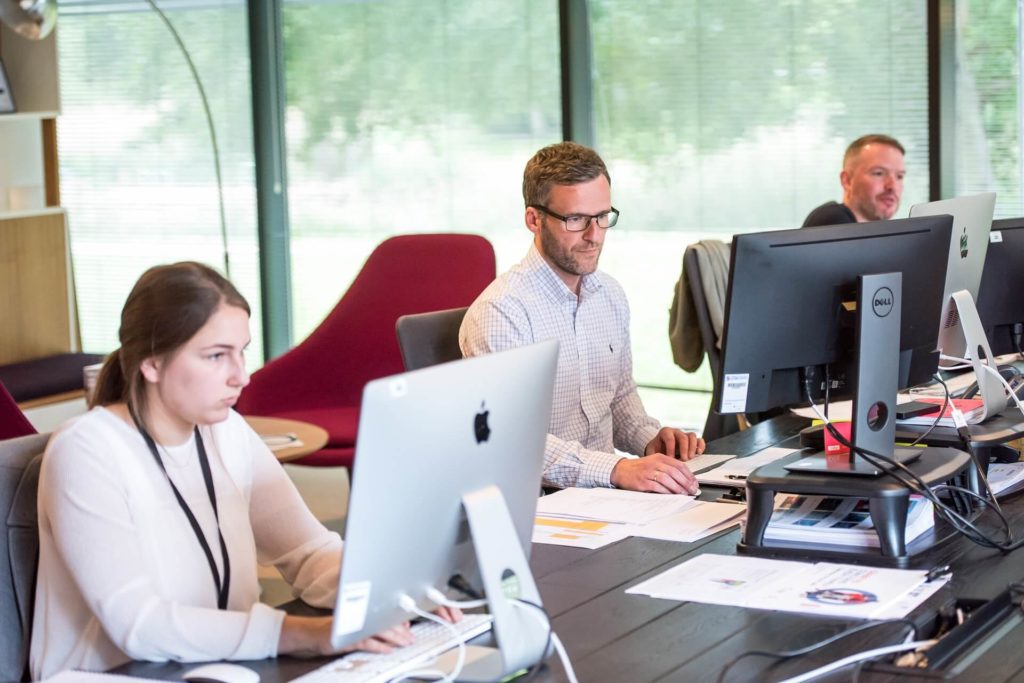Transcription and captioning are critical tools which must be provided to aid a variety of individuals. Without them, many such as those who are Deaf or hard-of-hearing can struggle to participate with equity. Transcription and captioning enable them to follow along with any audio and video they wish to consume in their free time or need to consume as a part of their daily role or responsibilities. To adhere to ADA guidelines, more businesses and content creators are utilizing transcription and captioning tools to ensure audio and audiovisual information and communication are accessible to these individuals.
Additionally, these services are helpful in sound-sensitive environments and additional use cases, such as aids to those with cognitive disorders or those consuming content in a non-native language. The use of captions and transcriptions can lead to stronger engagement, comprehension, focus and information retention for these additional populations.
Nearly every industry can benefit from offering captions and transcriptions with their content to make it fully accessible and engaging to everyone. Below are some of the ways that diverse industries can and are using captioning and transcription to improve accessibility and engage more audiences, students and employees.
Education and eLearning
Captions and transcriptions enable a variety of students to participate effectively, both live and while watching course content on-demand. Schools must provide accommodations for students with reported disabilities, such as hearing loss, who need these tools to participate. The benchmark for equity is typically 99%, which captioning providers such as Verbit are providing to universities such as the University of Florida and hundreds of others. One challenge also facing today’s universities is the lack of students reporting their disability needs. Schools which offer tools like captioning and transcription proactively to their student bodies can ensure all students are accounted for and student retention remains high, even when students do not come forward.
In addition to meeting students’ reported accessibility needs, school leaders who offer tools like captions and transcripts are likely to notice stronger comprehension of all students. These tools allow for all students to better engage with course materials and use them when studying. In fact, a study conducted by the University of South Florida St. Petersburg reveals that student performance improved in groups that utilized closed captions and interactive transcriptions. Student test scores increased by 3% for students using closed captioning and by 8% for those using interactive transcripts. All schools are well suited to offer these tools to adhere to ADA guidelines, as well as provide additional visual aids and helpful measures to further the chances of academic success of the entire student body.
Legal and court reporting
Providing an admissible transcript is critical for legal proceedings. However, due to a shortage of traditional trained personnel, such as stenographers, available to provide these transcripts, Transcription is a critical service when done through digital court reporting means. For the legal industry, technology such as Verbit’s digital deposition solution helps to deliver accurate, word-for-word live transcripts that accommodate the needs of legal proceedings specifically. Transcriptions ensure that everyone receives the same information, reducing the risk of misinterpretation that can complicate a legal proceeding. However, attorneys and others can benefit from live transcription tools and digital court reporting during proceedings themselves. With real-time transcripts, stakeholders can reference what was said during breaks, add notes to the interactive transcripts and more. Live transcription tools can go further than simply helping attorneys support the audio or video recordings presented as evidence after the fact. Additionally, access to digital court reporting tools helps smaller agencies scale their businesses and ensure that all proceedings are accounted for and captured accurately so that final transcripts can be provided seamlessly.
Media industry and journalism
Media professionals must ensure their content is accessible to all audiences due to FCC guidelines. Providing captioning on all live and pre-produced video aids in this task, as well as helps media reach more consumers. Captions can also aid individuals consuming the news or Netflix in languages which are not native to them. Verbit’s captioning and transcription solutions are tailor-made for media, offering professionals speaker identification, SMTPE time codes and other elements which made the captioning, transcription and overall production process less tedious. These solutions can be used to greatly aid in the production and distribution of talk and reality shows, documentaries, video interviews, movies, news and other programs. The benefits of closed captioning being offered for media therefore include increased accessibility, information retention, audience expansion and increased engagement, often leading to longer watch times.
Enterprise business for internal and external communications
With the move to more remote work and technology channels to fuel collaboration and communication, businesses are recognizing new work needs. Enterprise captioning and transcription tools are helping to empower more effective internal and external business communications. They’re being offered in a variety of business scenarios, including company town halls, on videos for product releases, tutorials, demos and sales pitches to help with engagement and notes from these meetings. For example, business leaders can provide real-time captioning of calls held via web conferencing tools, such as Zoom, and real-time transcription of business meetings and conferences to serve as post-event notes. Externally, captions and transcriptions are being incorporated on marketing materials, such as advertising videos, to ensure consumers and audiences can view them with equity and while in environments where sound cannot be played. Business leaders are finding that adding captions to videos and other marketing materials helps them better connect with consumers and clients in environments like social for example. Overall, captions and transcripts are helping professionals address accessibility and engagement needs to help a variety of customers and employees..
Event planning and conferences
With more virtual events and hybrid events expected going forward, ensuring remote event attendees and those who are present can engage with the event content and talks is essential. Live speech-to-text tools can ensure all professionals, event attendees and viewers can participate effectively in real time. These tools provide real time captioning and transcriptions of events and conferences held via web conferencing tools that participants can follow along with what is being said and benefit from note taking capabilities, which can be shared via transcripts after the events take place. Captions also help business leaders producing events to adhere to ADA or FCC guidelines when necessary to meet accessibility needs so that all attendees are provided with equal opportunities to participate.
Video production and influencers
To be accessible, all videos need to be captioned. With so many videos being created and shared on social media and being watched silently, captions can help to engage more viewers while they’re commuting, at work or in other quiet environments where the sound cannot be played as well. Caption and transcription services are helping video producers and influencers engage and reach wider audiences easily with integrations into platforms they’re using to host their videos, such as Vimeo and YouTube for example. Verbit is being used by many video content producers to caption videos in bulk and quickly so they can be uploaded with the caption files needed. Outsourcing these otherwise tedious tasks helps influencers and video creators add captions without having to produce them manually, which can be extremely time consuming in addition to captions, YouTube video transcription is being done more frequently as well, as many individuals and producers themselves want the full transcripts of everything being said. Transcripts can also help to make these videos not just more accessible, but searchable, which can enhance their SEO too.
The use cases of transcription and captioning are seemingly endless with more and more video being created and shared in a variety of industries and environments. Verbit’s captioning and transcription solutions stand apart from others in their ability to be customized to the needs of individual businesses and industries. Overall, the use of Artificial Intelligence to produce captions and transcripts can save businesses time. However, the equity piece comes forth when the captions and transcripts are provided are accurate. Verbit’s team of professional human transcribers and editors ensure that the technology is fact checked to reach 99%+ accuracy levels to adhere to ADA and FCC guidelines.
Regardless of the provider, business professionals should consider making their in-house and external environments and content more engaging and widely accessible to a variety of individuals and consumers across industries. Verbit’s captioning services and transcription capabilities continue to evolve to meet new industry needs as today’s industries evolve themselves.






